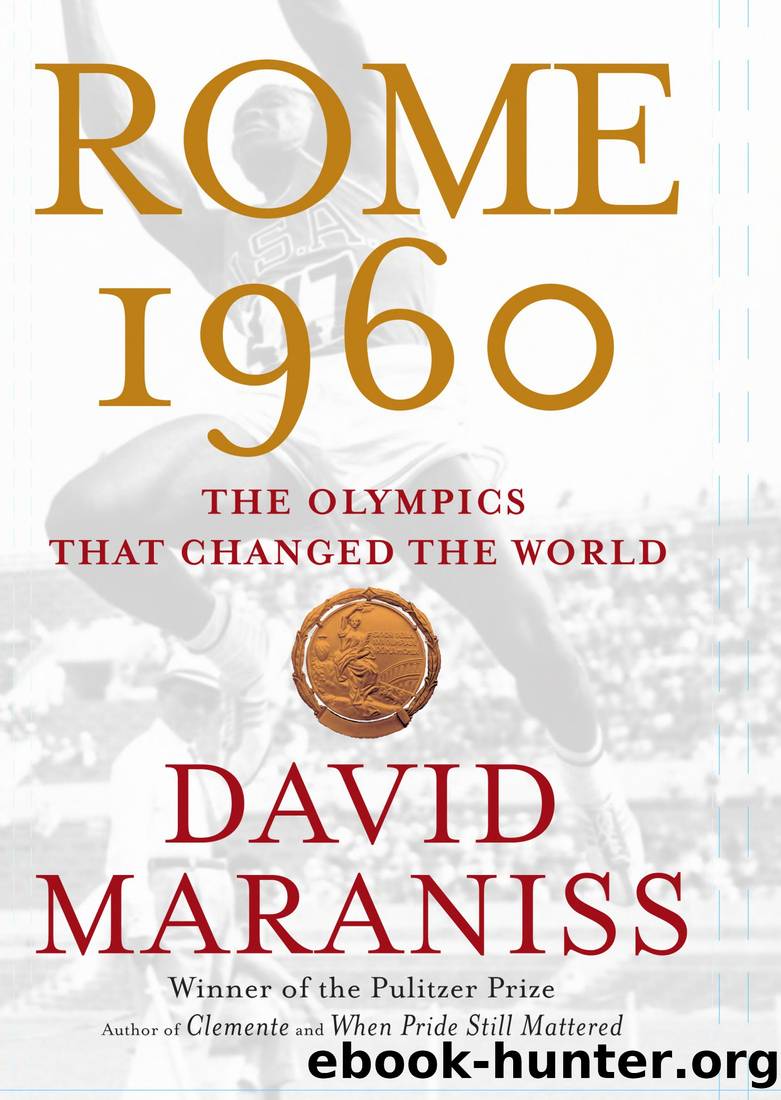Rome 1960: The Olympics That Changed the World by David Maraniss

Author:David Maraniss [Maraniss, David]
Language: eng
Format: epub
Tags: 20th Century, History, Non-Fiction, Olympics, Paralympics, Sports & Recreation, World
ISBN: 9781416534075
Google: 34Ye0xEedvYC
Amazon: 1416534075
Publisher: Simon & Schuster
Published: 2008-07-01T23:00:00+00:00
EARLY THAT evening at the Palazzetto dello Sport, a sellout crowd gathered for the most anticipated basketball match of the Games, the United States versus the Soviet Union. Tickets were so tight that James D. Zellerbach, the U.S. ambassador to Rome, had to make a personal plea to Avery Brundage to secure seats for his family. The little arena was so overflowing, noted Braven Dyer of the Los Angeles Times, that “if you took a deep breath, you were apt to shove somebody off the next seat. Rabid fans jammed the aisles and occupied every inch of standing room.” Some of the best views in the house ended up belonging to Bill Nieder and Dallas Long, gold and bronze medalists in the shot put, who had arrived without tickets but were corralled by Pete Newell, given USA warm-up suits, and placed down at the end of the bench. Newell was not expecting trouble, but it never hurt to have two musclemen nearby.
The United States, where basketball was invented in 1891, had dominated Olympic competition going back to the 1904 Olympics in St. Louis, when the Buffalo Germans, a team of six young men from a YMCA on the east side of Buffalo, won the championship. With basketball in its infancy and most countries still learning the rules, the St. Louis contests were merely exhibitions. The sport became an official Olympic event at the 1936 games in Berlin, where the USA won the gold medal by defeating Canada 19–8 on an outdoor packed-dirt court that turned muddy in a rainstorm. The Americans had never lost an Olympic match since, but going into Rome some observers said their basketball dynasty could be vulnerable, especially against the Russians.
Stepan Spandarian, the short, gray-haired Soviet coach, had issued a warning earlier that summer. “We can beat the Americans at the game they invented,” he said. He thought he had reasons to be optimistic. At the world championship in Santiago, Chile, in 1959, a U.S. team had lost to both the Soviet Union and Brazil, an unprecedented failure that was described in the New York Times as a “propaganda defeat of the first magnitude.” If U.S. prestige suffered from the Santiago fiasco, the losses there did not necessarily foreshadow long-term collapse. Construction delays in Chile had postponed the world championship for several months, and by the time they were held, the Americans were preoccupied with other responsibilities. Not an all-star team but a mediocre air force squad was finally sent, with predictable results. Spandarian was further encouraged when the Soviets toured the U.S. as part of the US-USSR Exchange Agreement and held their own against the best AAU teams. He knew the skills of Bob Boozer, Burdette Haldorson, Lester Lane, and Allen Kelley, all U.S. Olympians from the AAU ranks, but had no scouting reports on the American collegians. Of Oscar Robertson, he said, “He is only six-five. He cannot worry us as much as Bill Russell did at Melbourne.” The Soviets were taller and faster than ever, Spandarian claimed, and could run and shoot in the style of the West.
Download
This site does not store any files on its server. We only index and link to content provided by other sites. Please contact the content providers to delete copyright contents if any and email us, we'll remove relevant links or contents immediately.
Unstoppable by Maria Sharapova(3118)
The Inner Game of Tennis by W. Timothy Gallwey(2990)
Urban Outlaw by Magnus Walker(2950)
Crazy Is My Superpower by A.J. Mendez Brooks(2860)
The Social Psychology of Inequality by Unknown(2310)
The Fight by Norman Mailer(2158)
Unstoppable: My Life So Far by Maria Sharapova(2128)
Going Long by Editors of Runner's World(1920)
Accepted by Pat Patterson(1917)
Motorcycle Man by Kristen Ashley(1860)
The Sports Gene: Inside the Science of Extraordinary Athletic Performance by David Epstein(1822)
The Happy Runner by David Roche(1821)
Backpacker the Complete Guide to Backpacking by Backpacker Magazine(1815)
Sea Survival Handbook by Keith Colwell(1794)
Futebol by Alex Bellos(1784)
Mind Fuck by Manna Francis(1743)
Peak: Secrets from the New Science of Expertise by Anders Ericsson & Robert Pool(1662)
Endure by Alex Hutchinson(1605)
The Call of Everest by Conrad Anker(1550)
